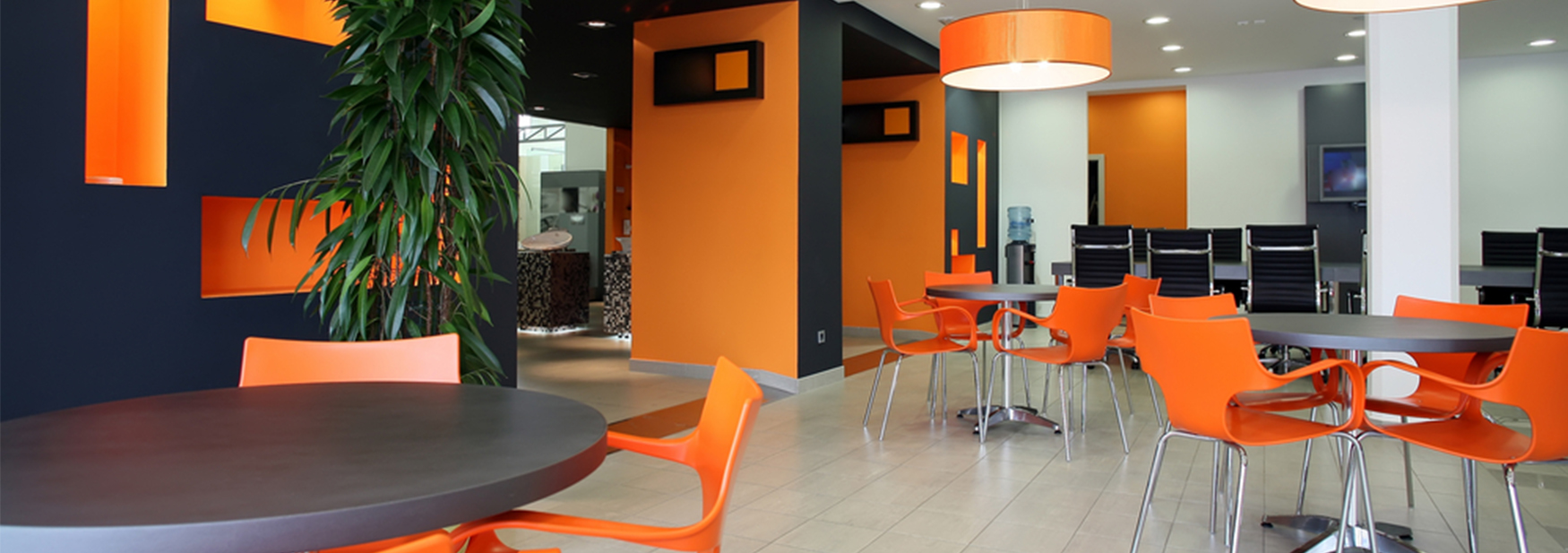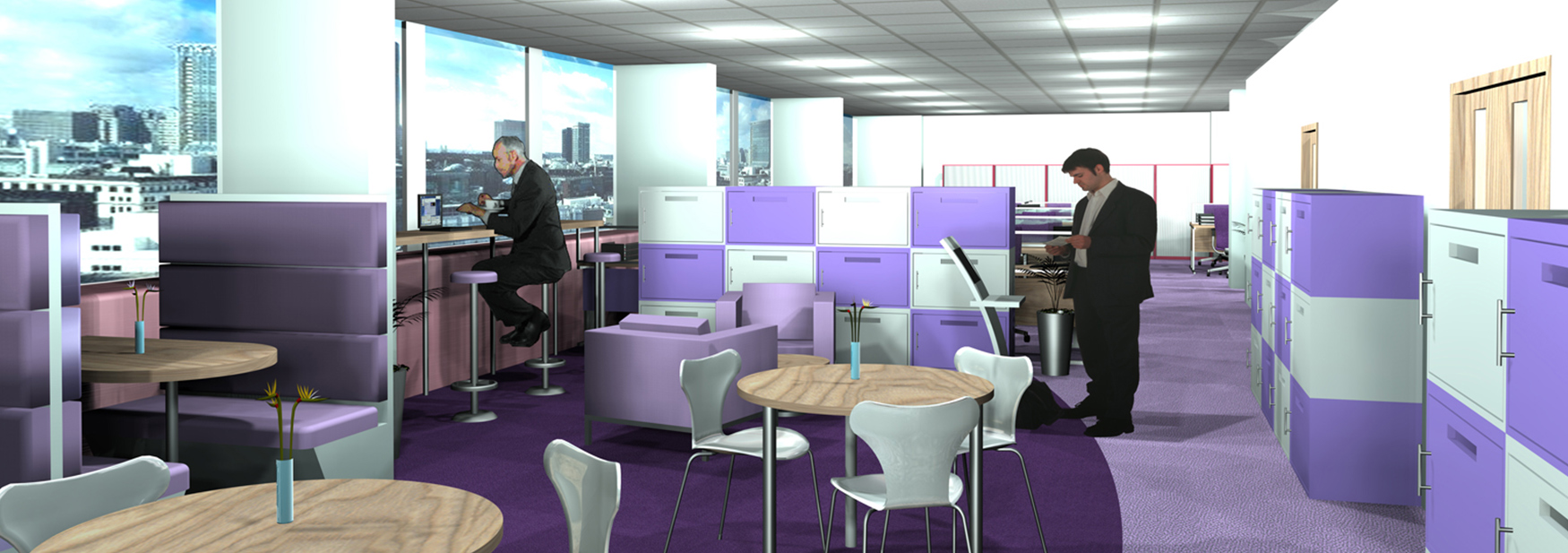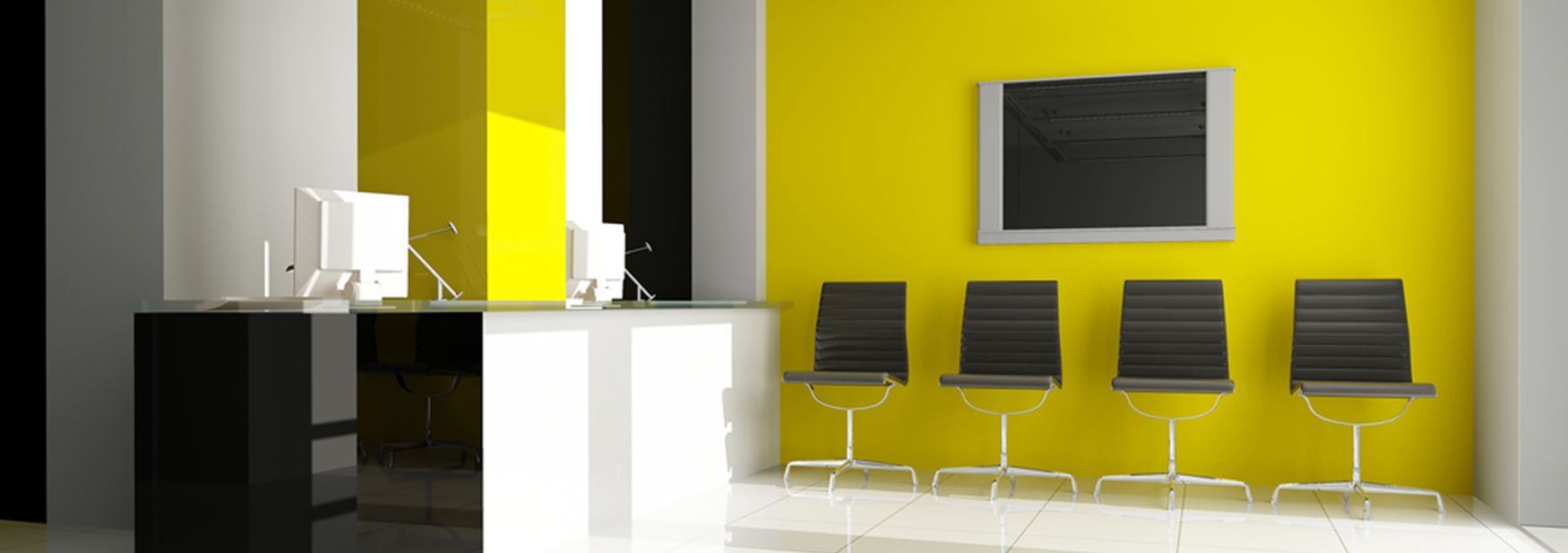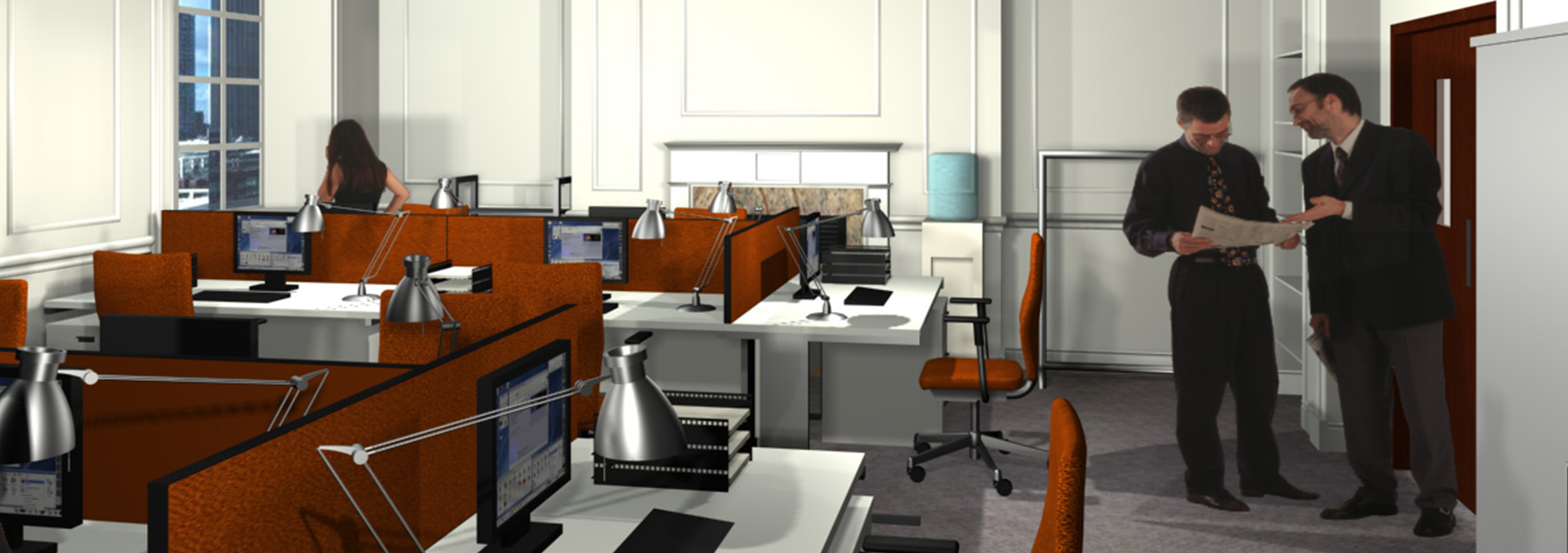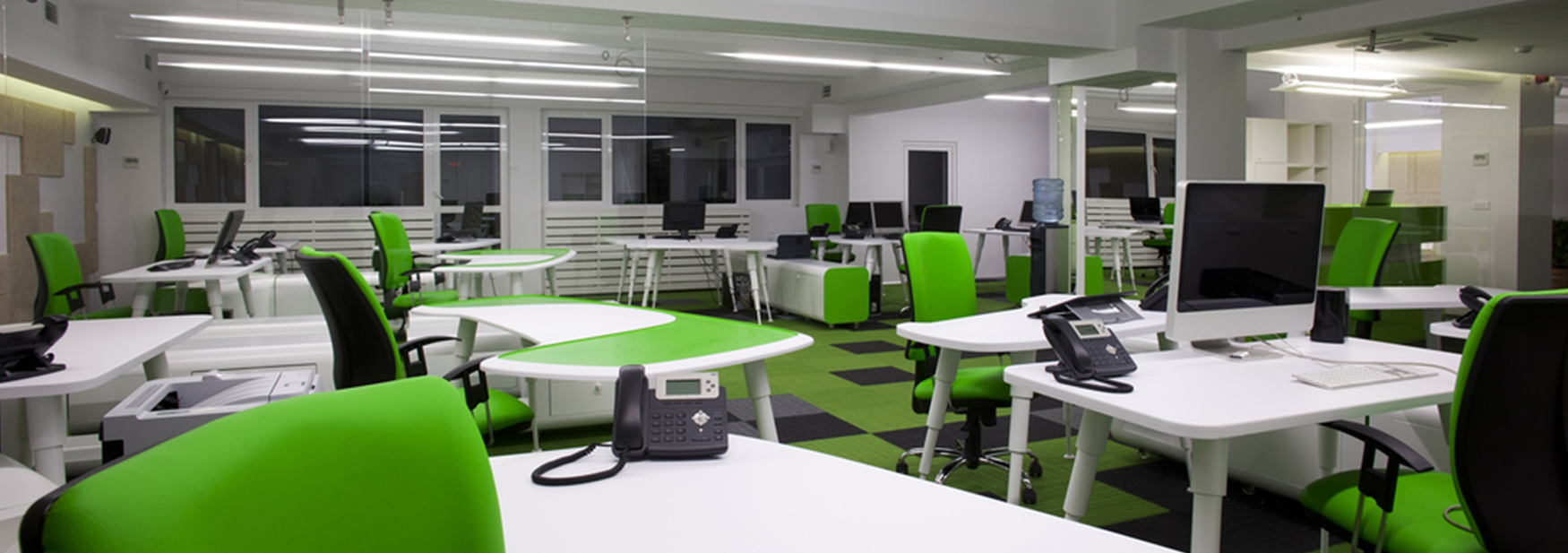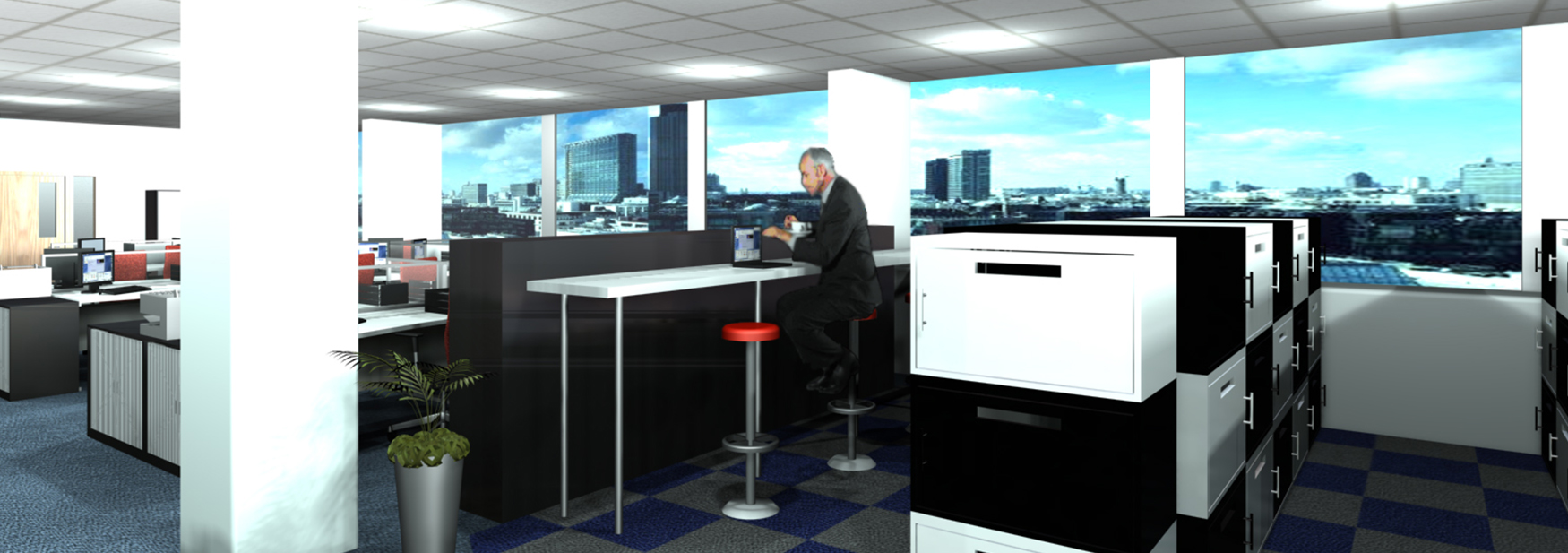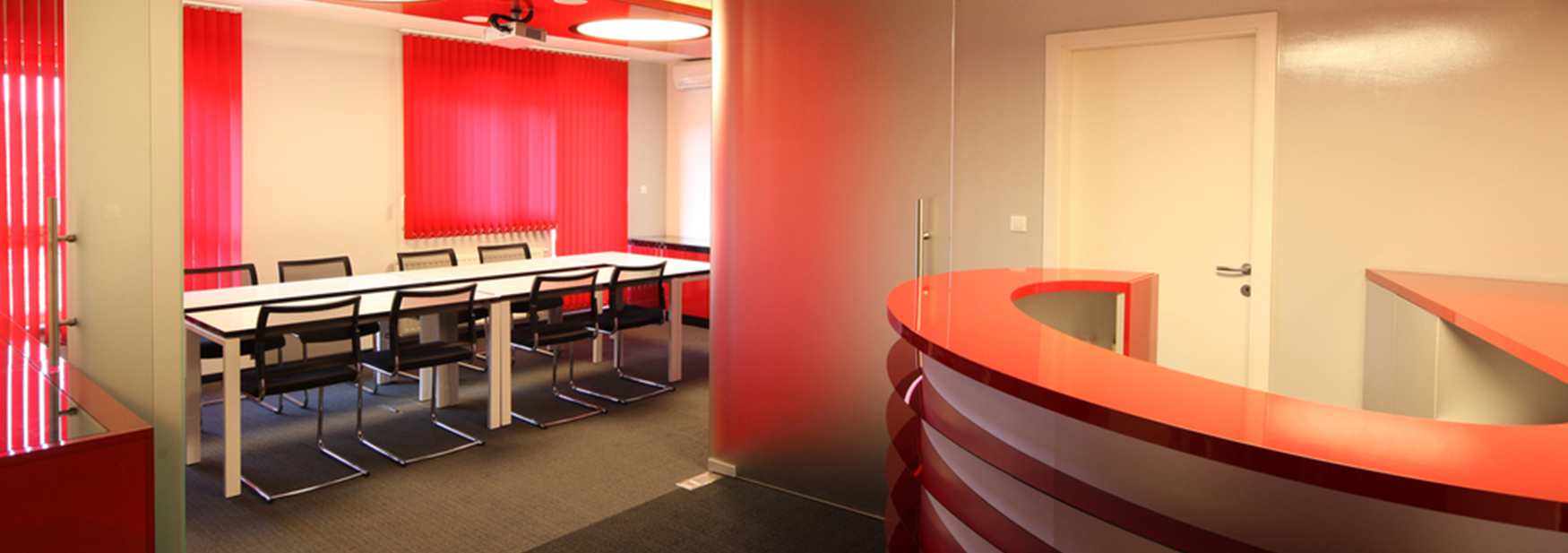The best way to ensure that the actual move goes smoothly is to begin with an “as existing” space plan that shows your current office design and layout, and has each item of furniture identified with a code number. This plan can then be printed out at large scale, or emailed to all your staff, allowing them to add the identifying code to each item of furniture (we can recommend companies that can do this also using low-tack adhesive labels that are attached to every item of furniture). Then at the new site, a large printed plan shows the same furniture with identifier codes showing the porters exactly where each item of furniture should be moved to. This simple system ensures that you don’t end up with bits of furniture in the wrong places, and therefore ensures that your new office design will be put in place accurately and in accordance with the proposed plans. If you would like more advice about office moves, give us a call on 0845 166 8381.
Author Archives: admin
Planning for an office move – part 1
When preparing for an office move there are many factors that often get overlooked. The first, and probably most important one is the office design. Often there is an assumption that just because the new office is larger, the will be no problem in fitting in the furniture, but there are many factors that can complicate the layout of office furniture, and often make spaces less useable than they should be. Important things to look out for include- is there a raised floor (as this allows more flexibility in the office layout design); are there pillars / power poles; is the floorplate an unusual shape; is the new office layout open plan, or made up of cellular offices? By starting with a furniture survey we can make sure that your furniture will fit in to your new office, but also we can ensure that it is laid out in the most efficient way. Our space planning service can also include 3d visuals and interior design, and we can even help to future proof your office, planning the layout to allow for potential expansion at a later date. This way our office design service can save you money in the future, and ensure that your staff are happy now. Give us a call to discuss how we can help- 0845 166 8381.
The advantages of maintaining a CAD file of your office layout
One of the first things we usually do as a part of a new project is to create a CAD (Computer Aided Design) drawing file of your office space as it is currently. We are then able to use this to see exactly what is where allowing us to know the locations of your partitions, doors, windows, heating and even your current furniture layout. Through our space planning process we would usually then produce a series of options as to how the new layout could look, and once complete the CAD file can be updated to ensure that it reflects the new current layout. Over time there are often many minor changes within an office layout, and we are able to come back to re-survey these, or often they can be carried out via a phone call. This then allows us to maintain an up to date plan of your office layout, which is useful for many reasons. Should you want changes to the layout in the future, these can then be produced quickly and easily using the source CAD plan, and a whole wealth of additional information can also be added such as staff names and telephone numbers, IT equipment, and even inventory tracking codes. You may also find it useful to give floor plans to new starters, and can show boundaries of different departments and their areas for charging purposes. By spending a small amount of time keeping this information up to date we are able to accurately maintain your office space plans and this will save you money in the long term, whilst also being a very useful information source about your working environment.
Bookable desking systems
You may be surprised to hear that approximately 40% of the time the average office desk is unoccupied during office hours. When you add up the amount of time that desk users are on leave, away due to illness, on courses, in meetings, or even just on lunch, it soon becomes clear that giving every member of staff their own dedicated desk may not be the best use of your valuable office space. There are many bookable systems that allow you to view exactly which desks are occupied at any time, and through using a system such as this you can increase the efficiency of your office space. The system doesn’t just apply to desks either as meeting rooms, training rooms, and manager’s offices are all spaces that could be used as a working environment if managed in a control manner. Through having better control over your desking you are able to free up space for other facilities for staff, such as breakout areas, coffee shops and even gyms; all of which are seen as a great asset to any employee.
We regularly work with companies that carry out time and motion and occupancy studies and we can recommend what would be your best course of action. Give us a call for more information.
The benefits of using an independent space planning company
You may have noticed that throughout our website we are very proud to state that we are an independent company, but what are the benefits of this? Well, put simply through being an independent company we are not tied to any supplier or product range. In fact our only aim is to ensure that our client gets the best possible service and value for money. A quick search of the web shows that there are actually very few independent space planning companies; many furniture suppliers offer a planning service (although this tends to be very different to our space planning service as we are happy to re-use your existing furniture), and there are many interior fit out companies, but again they are usually tied to their suppliers. Our independent status allows us to recommend the best possible solutions to your office design problems. We are able to recommend several furniture and fit out suppliers, and so we are able to obtain several quotes for you based upon our drawings and just a single site visit.
If you would like more information about our office design and space planning services, just give us a call.
Personalising your office reception
Your office reception is the first thing that visiting clients will see of your company and so it is vital that this area is kept up to date in order to make a good first impression. As well as looking good your office reception must be disability friendly, and this means that the standard tall reception counter is no longer such a good choice. Most modern reception counters now include a “cut away” section that is dropped to allow wheelchair users to access the counter, and it is also important to consider visually impaired visitors too, so raised glass surfaces may also be unsuitable. A good counter design will include space for storage underneath, as well as plenty of room for the reception staff, as this will be their primary workplace and so needs as much attention as any other workstation.
It is important to consider soft seating in a reception as visitors will need somewhere comfortable to sit while waiting, and fairly firm tub chairs and two seater sofas are a good choice here. Large sofas tend not to work as well as single seaters, so in a reception with limited space 2 or 3 single seaters and a small sofa would work well. Leather always wears well, especially in high traffic density areas, and is a good choice over fabric for anywhere that has users that may be drinking coffee.
Keeping visitors entertained whilst waiting is important, and a large flat screen displaying company information or a news channel is a god way of doing this. If there is the space an internet (or intranet) point can work well to allow visitors to catch up on work whilst waiting, and this can work well if combined as a touchdown counter with 2 or 3 stools that can double up as workspaces.
Receptions are the one area where you can go really bold with colours, or even use a modern lighting system to add changing colours to white walls. The key thing with any reception though is that it is designed with practicality in mind, and so must allow for adequate circulation space, especially as it is usually also the main fire exit. Call us to discuss how we can revamp your reception, and add a bit of life to your office!
Office flooring materials
We are often asked what materials are best to use in a modern office for flooring. This is an area where you can introduce a bold colour or design, and even use different colours to indicate different zones, or fire routes. Traditional carpets on a roll are not really ideal, as they can be tricky to repair (wear and tear and coffee damage happens far quicker in an office environment than it would in a domestic one due to the increased traffic). However carpet tiles are a good solution as they allow the user to replace single tiles at a time. If the carpet is made with a thick pile, then it is often hard to see any joins and the finish is similar to that of a roll, but without the drawbacks. Carpet tiles can also be useful when used with a raised floor as they can allow easy access to the wiring below the floor, and are usually supplied at the same size as the raised floor grid tiles (600×600mm). For areas such as coffee points where a carpet could quickly become stained a vinyl floor-covering works well. You can get a realistic wood effect vinyl that is actually laid in strips (like wooden planks) which allows for access under the floor should it be needed, and has several advantages over traditional wood, or laminate flooring products. One of the key advantages here is that the vinyl is quiet when walked upon; this may not seem a big deal, but many offices that were refurbished in the late 1990s with laminate floors soon found that the constant sound of heels on the wooden floor became a real problem. Vinyl is also very hardwearing and water resistant and so is a good choice for offices looking for a modern appearance. There are even companies that produce vinyl floor tiles that look like steel flooring for an industrial effect, or you can even get tiles with holograms set within them for a futuristic feeling.
For advice on office interior design, give us a call and we can discuss how we can bring your space up to date.
How a raised floor can improve your office layout
Most new build offices will be designed with a raised floor, but what exactly is this and how can it help to improve your office design? Basically a raised floor is a series of metal floor tiles laid over a raised grid that allow you to position electrical floor boxes anywhere within your office. This can then allow for much greater flexibility of office layout design as it means that desks do not necessarily need to be grouped in spurs coming directly off an external wall. The “spur design” tends to be the usual layout for most 1960s office buildings as these were designed with open plan in mind, but without knowing that the computer would become the standard office tool, and therefore access to electrical and network points would become so important. The raised floor allows the office furniture layout design to dictate the location of the floor boxes , rather than the position of electrical access points dictating the layout, giving the flexibility required to allow for islands of desks within an open plan office.
So, what can you do to have a more flexible layout if you don’t have a raised floor? Well, the first thing is that in order to avoid trailing cables, your most practical layout is likely to involve spurs of desks coming from the walls. However, you can also use any columns in the office in the same way, as it is relatively inexpensive to trunk power and data supplies up through a suspended ceiling and then down a column. Another way in which this can be implemented is via power poles; these work in the same way, having their supply via a suspended ceiling, but they can be moved, should the layout need to change in the future.
As more offices are going wireless and battery technology is improving we may soon be able to work completely wirelessly, and simply leave our laptops to charge overnight in a docking rack. This will give us a truly flexible office space and will no doubt have further impacts on office design.
Bringing the outside in to an office
The previous blog post discussed maximising natural daylight through office design, and this is the first step to helping to bring the outside in. Once your office is naturally lighter and brighter you can look at introducing some natural greenery through a few hardy indoor plants, and there are actually a number of companies that can not only supply the plants, but also offer a full maintenance service, to ensure that they stay looking at their best. A few simple large plants always look better than lots of little pots, and will also be easier to manage. The jungle look is never a good look for a modern office, and plants can get out of hand if unattended regularly, so it is always best to keep to the odd pot in desking areas (perhaps to mask an ugly column or other feature), and have a few more in breakout areas, being careful to avoid messy or fast growing varieties. There are even some very realistic plastic plants available now, but even these need a little maintenance, as they so tend to gather dust quite quickly, but these would be a good solution where the natural lighting is poor.
Once you have livened up the office with a few plants, a fresh colour scheme would also help and the current trends are for very natural colours (soft blues, greens, browns, along with plenty of white or white shades) rather than brash primary colours, and through our 3d modelling service we can show you exactly how your office design would look in a series of colour schemes. We can even show alternative space planning options with different colour schemes to give you a useful comparison, so if you would like to know more about our office interior design service, just give us a call.
Maximising your natural daylight through space planning and office design
We are often asked how can we help to make offices a little less cold and sterile, and a great way to do this is to maximise your natural daylight resources. The colour, feeling and effects of natural daylight just can’t be replicated by artificial light, and yet so many offices have poor layouts that block daylight within the office. A key principal here is to ensure that windows are not blocked by storage cabinets; the simplest way to do this is by putting all storage cabinets against partition walls. Most offices though have more storage cabinets than wall space, so the best way to ensure that natural daylight is maximised is to only ever have cabinets lined up perpendicular (at 90 degrees) to any windows. This may seem obvious, but so many offices have a row of tall cabinets running through the centre of the office space, and so these are actually parallel to the windows. What this then means is that one half of the office gets good natural daylight in the morning, but very poor in the afternoon and the other side vice versa. Through keeping the cabinets at 90 degrees some light is obscured, but you avoid the dark and light extremes. Of course investing in better storage solutions would help further, particularly a system such as a rolling stack (as discussed in earlier blog posts), as this would allow you to keep your storage in one area and so keep the open areas open.
As well as re-organising your storage, you should also look at the positioning of desks. A common mistake is to put a single manager’s desk (which is often unoccupied) next to the windows, with the bulk of the staff deeper in to the office floor plate away from the natural light. By ensuring that the natural light resource is maximised to as many workstations as possible, the overall feeling of the space for the staff will be improved. There are occasions, such as with a very large floor plate, when this can’t be done, and so here you may need to look as specialised lighting solutions, such as daylight simulation bulbs for individual desk lamps, and using as many transparent or translucent materials as possible around the office, such as frosted glass screens on desks rather than heavy fabric ones.
If you would like us to redesign your office to maximise your natural daylight resources, give us a call.
 space planning uk
space planning uk 